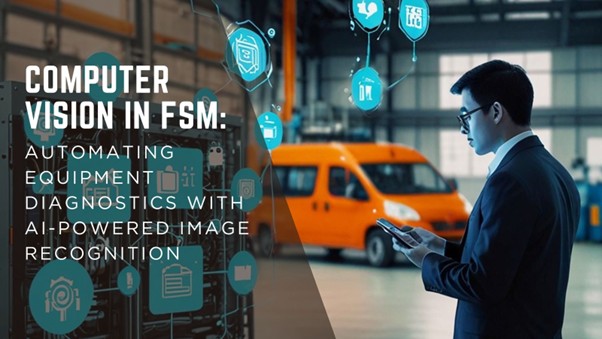Digital Twins in Field Service: Bridging the Physical-Digital Divide for Proactive Maintenance!

Quick Summary
In a field service management setting, the digital twins are redefining the predictive, preventive, and responsive nature of equipment within an organization. With the help of creating a virtual mirror of physical assets, field coworkers have the opportunity to observe real-time performance, identify anomalies, and implement predictive maintenance approaches. The blog will explore the purpose of digital twins in FSM and their use in reducing downtimes. We’ll also analyze how the FieldEZ solution can facilitate the transition between the physical and digital worlds.
Revolutionize Field Service with Digital Twins and Predictive Maintenance to Reduce Downtime and Costs.
The field service operations are in a digital transformation. The improvement of customer expectations and the increasing complexity of equipment increase the requirement for a service organization to implement new tactics for better serviceability, faster and more accurate maintenance. Digital twins are proving to be a game-changer by providing visibility and control never before seen: real-time, detailed replicas of physical assets.
With predictive maintenance at the forefront, digital twins in FSM enable proactive responses, reducing unscheduled downtime, cutting operational costs, and improving SLA compliance. This blog explores how this powerful technology bridges the physical-digital divide and why it represents the next significant leap for forward-thinking service providers.
Snapshot:
- Digital twins replicate real-world assets digitally for real-time monitoring
- Boosts predictive maintenance and anomaly detection
- Reduces unplanned downtime and service costs
- Enhances technician decision-making and remote diagnostics
- Supported by IoT, AI/ML, and cloud integration
- FieldEZ offers custom digital twin integration for FSM
What Are Digital Twins in Field Service Management?
Digital twins are virtual replicas of physical systems, assets, or processes. In field service, they simulate real-world behavior by mirroring sensor data, operating conditions, and historical performance in real-time.
How it works in FSM:
- IoT sensors collect real-time data from field equipment
- Data is fed into the digital twin model
- AI algorithms analyze the data for insights
- Field teams are alerted to anomalies or future failures
It is a dynamic representation that helps the FSM teams to monitor, diagnose, and maintain assets remotely, and they can predict in advance in many cases.
Why Digital Twins Matter in Predictive Maintenance
Predictive maintenance is a type of maintenance based on data analytics that enables the prediction of failures, even in advance. It, as well as digital twins, will transform field service management into a proactive strategy.
Traditional Maintenance | Predictive Maintenance with Digital Twins |
Scheduled intervals | Based on real-time performance |
Higher operational cost | Reduced downtime and field visits |
Reactive fault fixing | Early fault detection and avoidance |
Benefits:
- Extends asset lifespan
- Cuts unnecessary service calls
- Improves first-time fix rate
- Enhances compliance with SLAs and warranties
The McKinsey report also notes that predictive maintenance can lower the cost of maintenance and downtime by up to 25% and 35%, respectively.
How Digital Twins Power Proactive FSM
Digital twins are not just passive representations. They’re dynamic tools for decision-making, simulation, and prediction. By connecting field assets to a virtual environment, they allow service teams to intervene early. They also allow operational optimization and reduction of costly disruptions. Here’s how they support proactive service:
Real-time Monitoring:
- Gives continuous asset health data that enshrines temperature, vibration, voltage, and usage data.
- Notifies teams immediately about performance variations so they can respond and prevent minor problems before the services are affected.
Remote Diagnostics:
- Assists in locating the root cause of the problems before sending technicians, reduces travel time, and increases the first-time fix rates.
- Allows guided troubleshooting of live asset data, repair history, and diagnostic models, all the way to remote command centers.
Scenario Simulation:
- Predicts how assets will react under different environmental conditions, usage loads, or operational scenarios.
- Allows testing of software upgrades or configuration settings in a risk-free virtual model before actual deployment.
Data-Driven Scheduling:
- Matches technician visits exactly to actual asset needs and anticipated periods of failure and does a better job of putting the right workforce in the right place.
- Seeks to avoid over- and under-maintenance, which is a waste of resources and, at the same time, can lead to failure of equipment.
Key Technologies Behind Digital Twins in FSM
The convergence of multiple technologies is making digital twins practical and scalable:
Technology | Role |
IoT | Captures sensor data from equipment in the field |
AI/ML | Analyses data to detect patterns and predict failures |
Cloud Computing | Enables scalable storage and remote access |
5G Connectivity | Powers real-time data transmission and field interactions |
AR/VR (optional) | Enhances remote support and technician training |
Digital twins thrive on these technologies to function in high-velocity, complex FSM environments.
Applications of Digital Twins in Real-World Field Service Scenarios
Use Case 1: HVAC System Monitoring
Digital twins can enhance the maintenance of HVAC systems by replicating parts, such as compressors, motors, and ducts, in real-time. FieldEZ also identifies anomalies through the persistent observation of performance parameters, which results in prompt service requests.
Key Benefits:
- Tracks refrigerant pressure, fan speed, and airflow
- Predicts failures before customer complaints arise
- Automatically schedules technicians with context-aware alerts
- Reduces energy consumption and maintenance costs
This preventive measure enhances tenant comfort and extends the system’s lifespan.
Use Case 2: Smart Utility Infrastructure
Utility providers utilize digital twins to model and monitor grid assets, including transformers, pumps, and pipelines. Together with the FieldEZ predictive maintenance solution, they avoid expensive disruptions and compliance issues.
Capabilities include:
- Real-time monitoring of voltage loads and pressure levels
- Detection of equipment wear or potential leakages
- Predictive alerts sent to centralized maintenance teams
- Automated scheduling for critical asset checks
This will ensure continuity of service and maintain regulatory compliance.
Use Case 3: Telecom Tower Management
Digital twins serve as a representation of all the primary components of a telecom tower, including antennas, power modules, and cabling systems. In FieldEZ, providers can observe signal health, enabling proactive prognostication of any service interruption before it occurs.
Advantages:
- Detects abnormal voltage or temperature spikes
- Flags misalignment or hardware degradation
- Supports remote inspections via mobile dashboard
- Reduces downtime, especially in remote locations
This increases network reliability while optimizing technician deployment and reducing field visits.
FieldEZ’s Role in Digital Twin Integration
FieldEZ enables businesses to integrate digital twin technology into their field operations with minimal disruption. Here’s how:
Core Capabilities:
- Seamless integration with IoT and telemetry systems
- Real-time syncing of asset data into FSM dashboards
- AI-powered analytics and alerting workflows
- Mobile-first interface for technician access to twin data
- APIs for third-party data exchange and cloud platforms
Advantages of FieldEZ:
- Faster implementation and custom workflows
- Reduced ticket-to-resolution times
- Intelligent resource allocation using live twin insights
- Centralized asset lifecycle management
Client Impact:
Organizations that have implemented digital twins and predictive maintenance in field service have reported measurable improvements across key performance metrics:
- Up to 30% reduction in maintenance costs (Source)
- 25% improvement in technician productivity (Source)
- 35% reduction in unplanned equipment downtime (Source)
These outcomes highlight how digital twins can significantly improve efficiency, service quality, and cost-effectiveness in FSM environments.
Challenges and How to Overcome Them
Digital twin implementation, while transformative, has hurdles:
Challenges:
- High initial setup cost
- Data quality and consistency issues
- Integration with legacy systems
- Skills gap in data science and analytics
Solutions:
- Start small with high-value assets
- Use FieldEZ’s phased deployment and PoC models
- Leverage cloud-native infrastructure for lower CapEx
- Invest in training for technicians and back-office teams
The Future of Digital Twins in FSM
As AI evolves and IoT becomes more pervasive, digital twins will grow beyond asset replication to ecosystem simulation. Future trends include:
- Self-healing assets that auto-adjust without human intervention
- Twin-as-a-Service (TaaS) platforms for SMBs
- AI-driven decision twins that optimize technician routes, job prioritization, and inventory stocking
FSM is moving from a fix-and-forget model to a live-feedback loop, and digital twins are the backbone of this evolution.
Conclusion!
Digital twins make reactive field service, such as fire-fighting, a thing of the past, as field service is now both predictive and proactive in problem-solving. They enable a digital reflection of the physical world so that technicians can work more confidently and efficiently, reduce service outages, and provide ROI.
When your business is ready to leverage the potential of digital twins in FSM, with FieldEZ, you will be provided with the tools, integrations, and expertise to make your transformation a success story. Contact us today!



